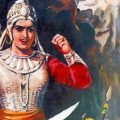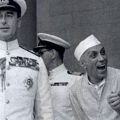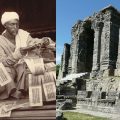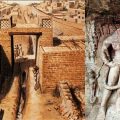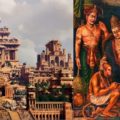Chronological History of Jammu and Kashmir: From Vedic Era to 1857
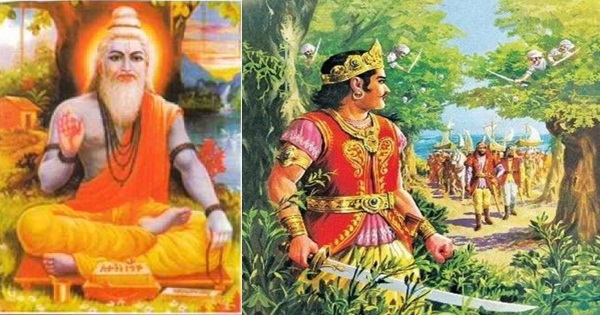
Jammu region was part of Madra Kingdom during early Rigvedic period. Madra kingdom was extended from the Sutlej River to the Indus River. Many rivers like Devikā, Apagā, Chandrabhāgā, Parushni, Iravati, Tausi, Urddha and Vishvamitra flowed in this region. Devikā River was the sacred river of Jammu region. According to Vedic legends, King Vyushitashva (13400 BCE?) of Puru dynasty, a descendant of King Madra (son of Shibi [13550 BCE]) reigned over Madradesha. His wife was Bhadrā Kakshivati. He had seven sons, four Madras and three Shalvas. Seemingly, the kingdom of Vyushitashva was divided into seven parts. Traditionally, Shākala was the capital of Madras and Sialkot was the capital of Shalvas. The Shalvas were a branch of Madras. Probably, Shambaras, the Asura Kings of Hariyupiya (Harappa) controlled this region around 11500-11300 BCE. Indra (11325 BCE) uprooted Shambara and annexed his kingdom. Kuru-Panchāla Kings extended their kingdom up to Pir Panjal hills in the north. Thus, Shalva (Sialkot) and JammuKashmir region up to Neelum River became part of Kuru-Panchala kingdom.
Most probably, a part of Kashmir valley was a glacial lake known as Satisar during Rigvedic period. This glacial lake was formed in Kashmir valley during the period of Meltwater Pulse 1A around 12700-11500 BCE. The closed Varahamula (Baramulla) pass was holding the melted waters of glaciers. Probably, a part of Hari Parvat of Srinagar was also under this glacial lake. According to Nilamat Purana, Pishachas (a tribe of early Rigvedic period) were living in Kashmir. Probably, they supported Asuras kings of Hariyupiya. Parvati requested Rishi Kashyapa to come to Kashmir and asked to purify the area of Pānchāla Giri (Pir Panjal region). Rishi Kashyapa came to Anantanag area of Pir Panjal hills along with his son Nila Nāga (also known as Viranāga) to support Shiva. Nila Naga or Viranaga defeated Pishachas. Rishi Kashyapa and his son Viranaga lived in Pir Panjal hills. Therefore, Pir Panjal hill range might have come to be known as Kashyapa-Meru. Thus, the name of Kashmir has been evolved.
At that time, one Asura named Jalodbhava occupied the island (Hari Parvat) in the middle of Kashmir glacial lake and used boats to plunder the villages on the western side of Satisar. Shiva and Vishnu tried their best to kill Jalodbhava but he used the heights of this island and somehow survived. Around 11200 BCE, a massive earthquake might have opened up Baramulla pass and the water of Satisar had flown out of Kashmir Valley which caused the great flood in Madra, Shalva, Sindh and Gujarat areas. Thus, Hari Parvat emerged out of Satisar and Jalodbhava perished. Kashmir valley became habitable after 11200 BCE.
Nila Nāga, son of Rishi Kashyapa became the first king of Kashmir. Nilamat Purana relates that Nila Nāga exiled Sadulanaga from Kashmir due to his evil behavior. Nila Naga allotted the mount Ushiraka in the land of Darva (Jammu) to Sadulanāga. Nāga Mahapadma reigned at Wular Lake. Thus, Nāgas established their reign in Jammu-Kashmir region around 11200 BCE. Gradually, Nagas gained the support of Pishachas and emerged as political rivals to Kurus and Panchalas. According to legends, Babhruvahana, son of Arjuna and Nāga Princess Chitrangada of Jaiminiya Ashvamedha era (11050 BCE) came to Jammu region and founded the city of Babhrupura (known as Babor). Kalhana of Rajatarangini refers to Babbapura. The legend of Sarpa Satra Yajna, King Parikshit was killed by Naga King Takshaka. Parikshit’s son Janamejaya performed Sarpa Satra Yajna and determined to kill Takshaka. Rishi Astika, son of Jaratkaru and Mānasā persuaded Janamejaya to set Takshaka free. Rishi Jaratkaru was a Yayavara Brahmana and married Mānasā, sister of Vasuki (son of Rishi Kahsyapa and Kadru). Thus, Rishi Astika was the junior contemporary of Kuru King Janamejaya of Asandivat. Most probably, the Sarpa satra yajna took place around 11225 BCE. Puranas mistakenly identified king Janamejaya as the son of King Parikshit of Mahabharata era.
Seemingly, Nāga kings reigned over Jammu-Kashmir after 11000 BCE. We have no information of Naga kings reigned over Kashmir from 11000 BCE to 5000 BCE. We have also no information of the descendants of Babhruvahana who reigned over Jammu region from 11050 BCE to 5000 BCE. According to the traditional history of Jammu, Ayodhya king Sudarshan (4800 BCE) had two sons, Agnivarna and Agnigira. The younger brother Agnigira migrated to Shivalik hills and settled in the region of present Kathua. He defeated the local kings and reigned at Bupanagari. He built the cities of Pushpavati. Kalidasa abruptly ends the history of Raghuvamsa after the death of Agnivarna (4800-4780 BCE). Seemingly, Ayodhya kingdom became politically vulnerable due to internal conflicts for succession after the death of Agnivarna. Kalidasa states that Agnivarna’s pregnant wife ascended the throne as the regent of unborn son of Agnivarna. This may be the reason why Agnigira had to immigrate to Jammu region. Vayusharb, son of Agnigira succeeded him. Muni Uttamacharya was his contemporary who lived in a Shiva temple at Airwan. He built the city of Airavati (known as Airwan today). Probably, Airavati was the wife of Vayusharb. After Vayusharb, Parmetra, Puran Singh, Lakshman, Khat-joshan and Agnigarbha reigned over Jammu region. Agnigarbha had 18 sons. Bahu Lochan and Jambu Lochan were the sons of Agnigarbha. Bahu Lochan shifted his capital from Airwan to Dharanagari, on the banks of Tawi. He founded the city of Bahunagar. He died in a conflict with Raja of Sialkot. Jambu Lochan, youger brother of Bahu Lochan succeeded him and killed Raja of Sialkot. He founded a vast kingdom. He also built a new city named Jambupura (old Jammu town).
According to Rajadarshani, the Ikshvaku kingdom was founded in Jammu region 550 years before the epoch of Kaliyuga but some traditional sources record that Jammu was founded 1999 or 900 years before the epoch of Kaliyuga. Rajadarshani also relates that there were 22 kings of Jammu line who ruled over Kashmir for 650 years. Another traditional source informs us that total 55 Jammu kings reigned over Kashmir for 1700 years. Gulabnama also records that 55 generations of Jammu rulers reigned over Kashmir. In all probability, Ikshvaku king Agnigira, brother of Agnivarna founded the rule of Ikshvakus in Jammu region 1999 years before the epoch of Kaliyuga. Therefore, we can roughly fix the date of Agnigira around 5100 BCE. A descendant of Agnigira conquered Kashmir and established the rule of Jammu kings around 4850 BCE. Total 33 kings reigned over Jammu and Kashmir from 4850 BCE to 3900 BCE. Seemingly, Jambu Lochan flourished around 3900 BCE founded the city of Jambupura. He was the contemporary of King Chandrahāsa of Madradesha. King Jambu Lochan defeated Chandrahāsa and took control over the Punjab. The Dogra tradition unambiguously indicates that Jambu Lochan flourished more than six centuries before the Mahabharata era. His son Puran Karan succeeded him. King Puran Karan had two sons, Daya Karan and Dharma Karan. Tarikh-eHasan relates that Jammu Raja Daya Karan sent a force led by his sons and conquered Kashmir.
From this time onwards, Jammu rulers continued to reign over Kashmir for 653 years. Thus, King Daya Karan and his 22 descendants reigned over Kashmir for 653 years from 3850 BCE to 3190 BCE. King Somadatta was the last Jammu king of Kashmir. King Gonanda I established his supremacy over Kashmir around 3190 BCE and founded the rule of the Gonanda I Dynasty. I have presented the chronological history of Kashmir starting from King Gonanda I in my article (click here).
Saran Dev, son of Bhau Dev was the distant descendant of King Daya Karan. Seemingly, Gonanda I had driven Saran Dev out of Kashmir. He came to Akhnur and founded Sahran state. Thus, Bhau Dev, the father of Saran Dev has been considered to be the progenitor of the Bhau Rajputs of Jammu. Kalhana wrote the history of Kashmir starting from King Gonanda I in his Rajatarangini. Around 3850 BCE, Daya Karan became the king of Kashmir and his younger brother Dharma Karan became the king of Jammu. Kirti karan, Agni Karan and Shakti Karan were the successors of King Dharma Karan. King Shakti Karan was a great learned man. He introduced the calendar of “Shastra Era” (Saptarshi Samvat) which begins from the bright fortnight of Vaishakha month. Probably, King Shakti Karan also known as Raja Shastri might have introduced the Shastra era around 3777 BCE. Many inscriptions of Chamba kings are found to be dated in the Shastra era. The epoch of Shastra era is found to be identical with that of Saptarshi Samvat. Interestingly, it is recorded in ancient Jammu legends that King Shakti Karan or Raja Shastri had innovated the Dogra script. The modern Dogra Script is derived from Sharada script which is in turn derived from Brahmi script. Probably, Raja Shastri had innovated the Brahmi Script. King Shiv Prakash, a descendant of King Shakti Karan was ruling over Jammu during the Mahabharata era. King Shalya of Madra kingdom, the maternal uncle of Nakula and Sahadeva invaded Jambupura and annexed it. King Shiv Prakash took shelter in inner mountains. Many generations of King Shiv Prakash lived in mountains.
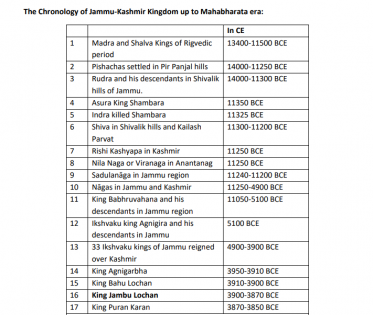
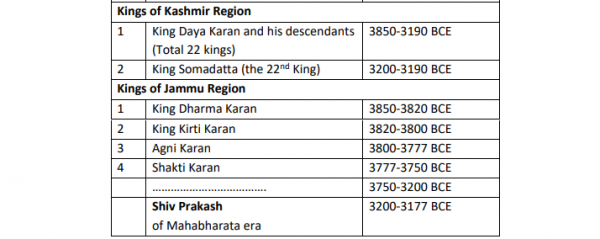
The Chronology of Jammu after Mahabharata Era
According to Gulabnama written by Diwan Kriparam, Jyoti Prakash and Sarva Prakash (Sari Prakash or Jai Dev), the descendants of King Shiv Prakash of Mahabharata era re-conquered Jammu with the assistance of Charak clan and established their rule in the 444th year of Kaliyuga. During the reign of Brahma Prakash, Jammu was devastated by the great flood. The Chronology of the descendants of King Jyoti Prakash:
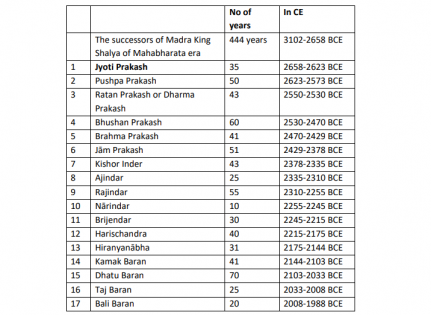
King Bodh Arjun the Great (1988-1908 BCE)
According to Vanshavali of Jammu, King Bodh Arjun ascended the throne after King Bali Baran. He was the greatest king of Jammu and reigned for 80 years. Probably, he became a king at very young age. He conquered up to Bengal and Kamarupa in the east, Kanyakumari and Sri Lanka in the south and Gujarat, Sindh and Multan in the west. He also married a Sri Lankan princess. His seven descendants reigned for 357 years.
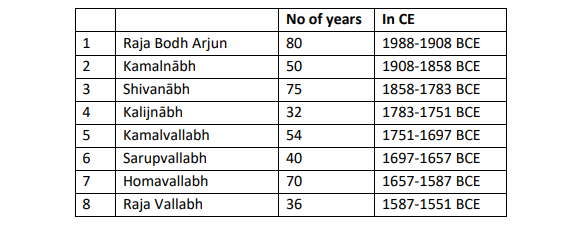
King Mangal Chand Katoch of Kangra-Nagarkot of Himachal Pradesh invaded Jammu and killed Raja Vallabh around 1503 BCE. Bhanu Yaksha, a cousin of Raja Vallabha revolted against Mangal Chand and killed him in a battle. Thus, Bhanu Yaksha founded the rule of his dynasty in Jammu. At that time, Yavana kings of Talshashila invaded up to Saketa and Magadha during the reign of Maurya king Shalishuka (~1503 BCE) as recorded in Yuga Purana and started expanding their kingdom. They also conquered Jammu region. Thus, Bhanu Yaksha and his descendants ruled as vassals of Takshashila.
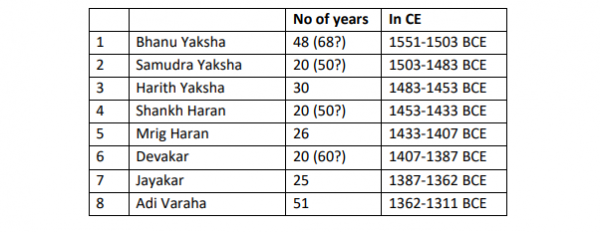
There is a reference in Jammu Vansavali that the line of kings from Adi Varaha to down Damodar Dutt, a dynasty of 8 kings ruled from Takshashila. Seemingly, Jammu kings also controlled a part of Madra country during this period. Damodar dutt might have lost his control over Madra kingdom due to the rise of Kushanas.
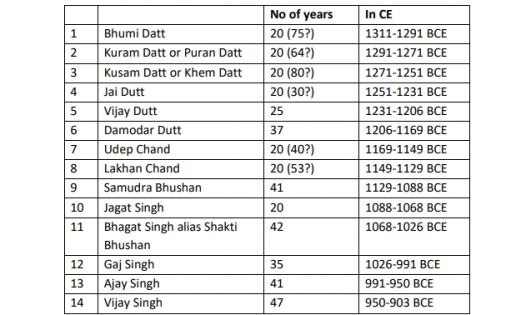
Interestingly, Firishta mentions that Kaid Raja (Most probably, Kushana Kings Kanishka and Huvishka) reigned over Punjab for some decades. He built the fort of Jammu and appointed Durg of Ghakhar tribe (Khokhar) as governor. According to Firishta, the fort of Jammu remained under the possession of Ghakkars from the time of King Durg to the Mughal period. The Kaid Raja (Huvishka’s successor) appointed Jai Chand as his governor in Delhi. Raja Dilhu, the younger brother of Jai Chand (1040-1030 BCE) ruled over Delhi for 40 years around 1030-990 BCE. King Puru Sen of Madra country killed Raja Dilhu and annexed the region of Delhi.
According to Jammu Vanshavali, King Puru Sen or Purva Sen was the king of Madra country and he was the contemporary of Jammu king Ajay Singh, the 7th descendant of Damodar Datt. King Ajay Singh married Rani Mangalan Dai, the daughter of Madra King Purva Sen. Undoubtedly, King Purva Sen or Puru Sen of Madra country was the “Poros” referred to by Greek historians. He was the contemporary of Alexander. His capital was Gotipani which was situated on the east of Behat (Probably, Islamabad or Rawalpindi). Raja Puru Sen conquered all the territories on the Sindhu River. His kingdom was extended from Indus River in the west to Jalandhar and Chamba kingdoms in the east. Seemingly, Raja Puru Sen defeated Alexander and one of his soldiers shot an arrow and injured Alexander around 984 BCE. Thus, we can roughly fix the date of Ajay Singh around 991-950 BCE and the date of Madra King Puru Sen around 1000-950 BCE. Later, Raja Ajay Singh of Jammu was killed while fighting on the side of King Puru Sen, his father-in-law.
Considering King Puru Sen (Poros) and his son-in-law Jammu king Ajay Singh as the contemporaries of Alexandar (~984 BCE) and Seleucus (965-941 BCE), I have corrected the number of regnal years of the Jammu Kings from Bhanu Yaksha to Ajay Singh as indicated in the Gulabnama. Interestingly, Firishta relates that after the war between Raja Fur (King Puru Sen or Poros) and Iskandar (Alexandar), King Sansara Chandra (Chandragupta of Chandra dynasty) seized the reins of Hindustan. Tibetan monk Taranatha refers to him as Buddhapaksha. Jammu Vamshavali records that the following four kings reigned after King Vijay Singh.

The Rai Dynasty (719-178 BCE)
Adi Rai was the progenitor of the Rai dynasty of Jammu. He was the contemporary of Vikramaditya I who founded the epoch of the Karttikadi Vikrama era [719 BCE] (also called as Malavagana era or Krita era). Adi Rai reigned for 48 years and was succeeded by his son Dev Rai. Gandharva Rai was the son of Dev Rai. According to Baharistan and Tarikh-i-Sialkot, Jog Rai ascended the throne in Vikrama Samvat 484 (235 BCE).
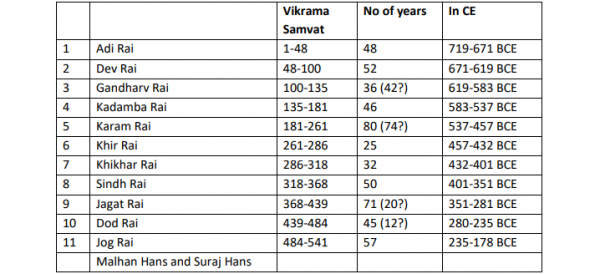
King Deva Rai and St. Andrews
Lala Ganesh Dass mentions in his Rajadarshani that St. Andrews visited the court of Jammu King Dev Rai and presented two documents written in Assyrian language. The descendants of Dev Rai kept these documents in safe custody but got lost during the reign of Akbar. King Ranjit Dev ordered a thorough search but these documents could not be traced. There is a serious need to investigate the authenticity of this legend.
King Shalivahana (660-580 BCE), the founder of the city of Sialkot
The traditional legends relate that Raja Shalivahana of Malava, Ujjain and South India conquered Punjab and founded the city of Shālikot (Sialkot). He was the contemporary of Jammu kings Gandharva Rai and his son Kadamba Rai. Evidently, Sialkot city was not existed during the time of Alexandar (984 BCE). Therefore, Shākala city cannot be identified with the city of Sialkot.
King Gaj and his son Shalbahan
According to Yadu-Bhatti annals, Raja Gaj founded the city of Gajapura (known as Ghazni) in the 3008th year of Yudhishthira era. Considering the epoch of Mahabharata war and Yudhishthira era (3162 BCE), Raja Gaj built the city of Ghazni in 154 BCE. He invaded Kashmir and married a princess of Kashmir. He had a son named Shalbahan. Historians mistakenly assumed King Shalivahana of Ujjain and Raja Gaj’s son Shalbahan as identical. In fact, King Shalivahana lived around 660-580 BCE whereas Raja Gaj’s son Shalbahan flourished around 150-80 CE. According to Jammu legends, Shalbahan conquered Punjab and founded a city named Shalbahanpura. King Shalbahana had 15 sons. His son Raja Rasalu married princess Luna of Chamba. Raja Hodi (Kidarite King) of Peshawar was the enemy of Raja Rasalu. There is a mention of Samvat 72 with reference the foundation of Shalbahanpura. In all probability, Yadu Bhatti annals mistakenly quoted the date of Samvat 72. It was King Shalivahana of Ujjain who founded the city of Shalivahanapura (Sialkot) in Karttikadi Vikrama era 72 (647 BCE).
Kashmir King Hiranya and his son Pravarasena II
According to Jammu legends, when Kashmir King Hiranya was imprisoned by his brother, his wife took shelter in the house of a potter in Jammu. She gave birth to Pravarasena II. Sh. Ganesh Dass states that Dev Rai and Gandharva Rai were the kings Jammu when Pravarasena II was born and brought up in Jammu. Sh. Ganesh Dass simply followed the chronology given by Kalhana. I have established that there is an error of 300 years in the chronology given by Kalhana. King Hiranya reigned around 441-411 BCE. King Harsha Vikramaditya appointed Matrigupta as king of Kashmir around 410 BCE. After the death of Matrigupta, Pravarasena II ruled over Kashmir around 405- 345 BCE. Thus, Pravarasena II was the contemporary of Kings Khikhar Rai and Sind Rai of Jammu.
The Dynasty of King Suraj Hans
Suraj Hans was the son of King Jog Rai (235-148 BCE). His elder brother Malhan Hans reigned in Sialkot whereas Suraj Hans became the king of Jammu in 178 BCE. He was the contemporary of Sasanian king Anushirwan (129-81 BCE). On the request of Anushirwan, Pandit Brij Basi, a councillor of Raja Jammu facilitated the translation of Panchatantra into Persian language which is known as Kalila-o-Dimma. The chronology of King Suraj Hans and his descendants:
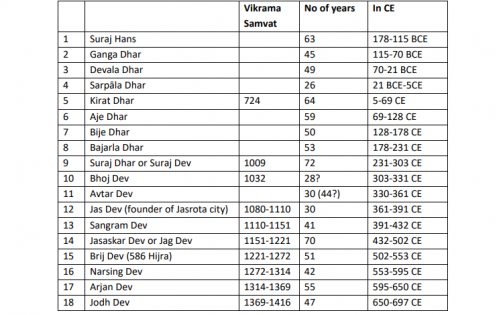
King Mal Dev (697-737 CE)
According to Gulabnama, King Maldev reigned for 40 years and died in Vikrama Samvat 1456 (737 CE).
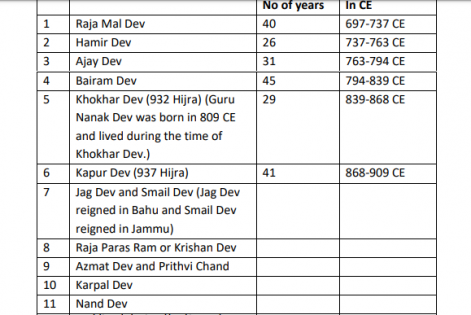
King Smail Dev and his descendants:

The chronological history of Jammu needs a careful verification of facts during the time of Dhruva Dev and Ranjit Dev. Due to the chronological error of 660 years, there are some contradictory dates for the historical events. Seemingly, Jammu kingdom had suffered a lot due to invasions of Nadir Shah and Ahmed Shah Durrani during the time of Dhruv Dev and Ranjit Dev. Traditional sources indicate that Dhruvadev reigned for 30 years but historians assign only 22 years for Dhruva Dev. Therefore, the Chronological history of Jammu from 1063 CE to 1782 CE needs to be reconstructed.
After 1725 CE

The Kings of Basholi or Balor or Vallapura
The Kings of Basholi claim their descent from the Pandavas of Mahabharata era. They belong to Chandravamsha. They settled in Babhrupura or Babbor in Jammu after Mahabharata era. Later, they had to settle at Vallapura (Balor) due to the rise of Jyoti Prakash dynasty around 2658 BCE. Kalhana refers to king Kalasa of Vallapura (Balor) who was the contemporary of Kashmir King Kalasha (363-383 CE). King Bhog Pal (765 CE) was the founder of a dynasty that reigned over Bhasholi after 765 CE. We have the list of latest rulers of Bhasholi:
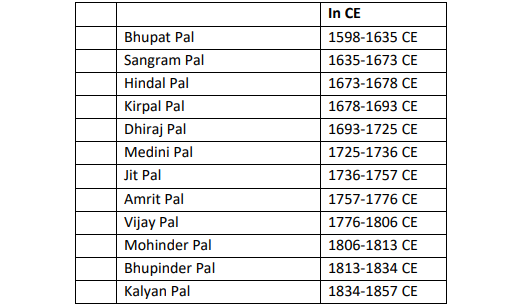
This research paper was first published in academia.edu.
Featured image courtesy: Booksfact and YouTube.
Vedveer Arya
Latest posts by Vedveer Arya (see all)
- How Salaries Were Paid to Temple Staff in Early Medieval Bharat - October 23, 2024
- A Genealogical Account of Bhrigu Gotra from Saptarshis - October 23, 2024
- Saptarshis: Lineages of Angirasa gotra from 14050 BCE - October 23, 2024

